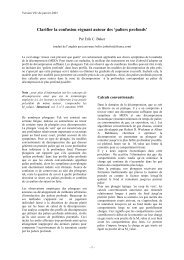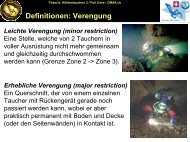cave diving and the nss - bei Swiss-Cave-Diving
cave diving and the nss - bei Swiss-Cave-Diving
cave diving and the nss - bei Swiss-Cave-Diving
Create successful ePaper yourself
Turn your PDF publications into a flip-book with our unique Google optimized e-Paper software.
this, but it's not m<strong>and</strong>atory.<br />
The second limitation is that this book is written not for <strong>the</strong><br />
general public, or even for <strong>the</strong> general <strong>diving</strong> public, but for <strong>cave</strong> divers<br />
<strong>and</strong> student <strong>cave</strong> divers—or more precisely, for people who have had,<br />
or who are in <strong>the</strong> process of receiving, <strong>cave</strong>-<strong>diving</strong> training under <strong>the</strong><br />
guidance of a certified <strong>cave</strong>-<strong>diving</strong> instructor. This book is intended<br />
to serve as an adjunct to that training <strong>and</strong> in no way as a substitute<br />
for it.<br />
And that brings us to <strong>the</strong> third limitation, which is that this book<br />
is only a book. It cannot shout at you, hit you over <strong>the</strong> head, tie you<br />
up, or in any o<strong>the</strong>r way—o<strong>the</strong>r than <strong>the</strong> oh-so-flimsy method of rational<br />
discourse—dissuade you from attempting to use <strong>the</strong>se techniques in<br />
a <strong>cave</strong> without <strong>the</strong> proper training.<br />
We hope that if you are reading this from a perspective lacking<br />
<strong>cave</strong>-<strong>diving</strong> training, you will appreciate <strong>the</strong> gravity of our warning, if<br />
only from a sort of indirect inference from <strong>the</strong> kinds of things that<br />
are <strong>bei</strong>ng communicated about, such as total loss of visibility, line<br />
entanglements, disorientation, air failures, <strong>and</strong> <strong>the</strong> ultimate nightmare—<strong>bei</strong>ng<br />
lost off <strong>the</strong> line in a complete siltout—a thing that can<br />
(<strong>and</strong> unfortunately all too often has) happened very easily to people<br />
with no training, even just right inside <strong>the</strong> entrance of a nice, "innocentlooking"<br />
<strong>cave</strong>. (And if that doesn't convince you, hold this book ten<br />
inches directly above your head <strong>and</strong> let go.)<br />
"Drowning" is believing. In a course under a certified instructor<br />
you will be allowed to "drown"—to realize that if that training drill had<br />
occurred under genuine <strong>cave</strong> conditions, you surely would have<br />
drowned. Our accident statistics <strong>and</strong> analyses point to a lack of<br />
training (or in a few cases, ignoring one's training) as <strong>the</strong> fundamental<br />
contributing cause of death in <strong>the</strong> overwhelming majority of underwater-<strong>cave</strong><br />
fatalities. The real tragedy is that nearly all of <strong>the</strong>se accidents<br />
could have been easily preventable, just with <strong>the</strong> proper training,<br />
proper equipment, <strong>and</strong> some self-control.<br />
Our interest is in your <strong>diving</strong> safety, efficiency, <strong>and</strong> enjoyment.<br />
We have gladly volunteered our time <strong>and</strong> efforts in writing this book<br />
in <strong>the</strong> hope that <strong>the</strong> information presented will enhance your <strong>cave</strong><strong>diving</strong><br />
learning process <strong>and</strong> overall <strong>cave</strong>-<strong>diving</strong> safety. But you have<br />
to do your part, too, <strong>and</strong> use good judgment in applying it.<br />
Safe <strong>diving</strong>!<br />
H. V. Grey<br />
Chapter One<br />
INTRODUCTION<br />
Years ago while <strong>diving</strong> an ocean blue hole in <strong>the</strong> Bahamas,<br />
<strong>the</strong> authors of this book had a ra<strong>the</strong>r amusing "failure to communicate."<br />
Prosser was in <strong>the</strong> lead <strong>and</strong> spotted his first underwater<strong>cave</strong><br />
shark. He circled it with his light to draw Grey's attention to<br />
it. The viz wasn't so hot <strong>and</strong>, <strong>bei</strong>ng off a few feet to one side, Grey<br />
didn't see <strong>the</strong> shark, only <strong>the</strong> circling light motion, which ordinarily<br />
means, "I'm okay." Grey thought, "Well, that's nice. I'm certainly<br />
glad you're okay—I mean, I can that see you're okay. But, since<br />
you asked, I'm okay, too"—<strong>and</strong> made an answering circular light<br />
signal. Prosser thought, "Well, gee, I guess if my buddy's not<br />
worried about <strong>the</strong> shark, <strong>the</strong>n it's okay to keep on going . . ."<br />
Fortunately, of course, it was a very courteous, gentlemanly<br />
shark, <strong>and</strong> <strong>the</strong> dive proceeded without incident. Most failures to<br />
communicate in a <strong>cave</strong> in fact do not have lethal consequences,<br />
<strong>and</strong> <strong>the</strong>re probably isn't a <strong>cave</strong> diver alive who can't relate some<br />
ludicrous tale of comical misunderst<strong>and</strong>ings underwater. But it<br />
should be more than clear that <strong>the</strong> potential for disaster certainly<br />
exists.<br />
For example, despite all precautions to remain properly<br />
oriented, arguments underwater about which way to go to exit <strong>the</strong><br />
<strong>cave</strong> are not as uncommon as one might hope. Occasionally <strong>the</strong>y<br />
have tragically resulted in a team splitting up <strong>and</strong> only some of <strong>the</strong><br />
buddies making it out alive. While this is certainly preferable to<br />
having all of <strong>the</strong> divers drown, it does point to <strong>the</strong> some of <strong>the</strong><br />
limitations of nonverbal communication. It may be impossible to<br />
try to explain your reasons for favoring one direction over ano<strong>the</strong>r<br />
using only one-h<strong>and</strong>ed signals, <strong>and</strong> <strong>the</strong>re isn't always <strong>the</strong> time or<br />
visibility, or even <strong>the</strong> space, to hold an extended conversation with<br />
slates.<br />
Underwater-<strong>cave</strong> communication begins on <strong>the</strong> surface, when<br />
viii















